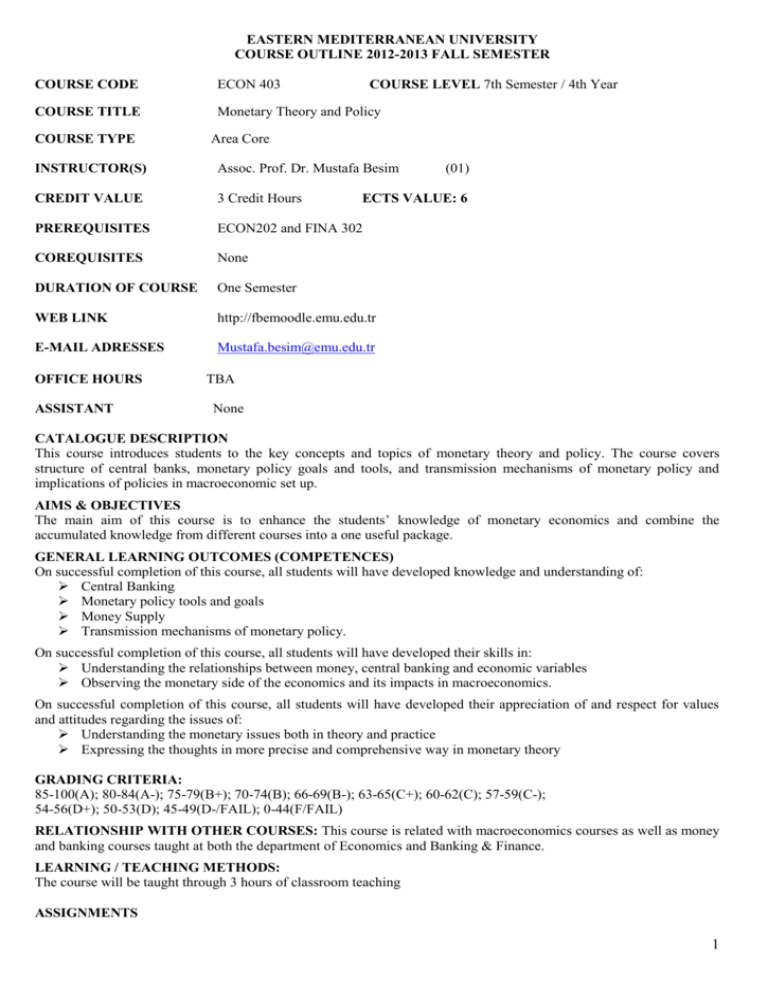
EASTERN MEDITERRANEAN UNIVERSITY
COURSE OUTLINE 2012-2013 FALL SEMESTER
COURSE CODE
ECON 403
COURSE TITLE
Monetary Theory and Policy
COURSE TYPE
COURSE LEVEL 7th Semester / 4th Year
Area Core
INSTRUCTOR(S)
Assoc. Prof. Dr. Mustafa Besim
CREDIT VALUE
3 Credit Hours
PREREQUISITES
ECON202 and FINA 302
COREQUISITES
None
DURATION OF COURSE
One Semester
WEB LINK
http://fbemoodle.emu.edu.tr
E-MAIL ADRESSES
Mustafa.besim@emu.edu.tr
OFFICE HOURS
ASSISTANT
(01)
ECTS VALUE: 6
TBA
None
CATALOGUE DESCRIPTION
This course introduces students to the key concepts and topics of monetary theory and policy. The course covers
structure of central banks, monetary policy goals and tools, and transmission mechanisms of monetary policy and
implications of policies in macroeconomic set up.
AIMS & OBJECTIVES
The main aim of this course is to enhance the students’ knowledge of monetary economics and combine the
accumulated knowledge from different courses into a one useful package.
GENERAL LEARNING OUTCOMES (COMPETENCES)
On successful completion of this course, all students will have developed knowledge and understanding of:
Central Banking
Monetary policy tools and goals
Money Supply
Transmission mechanisms of monetary policy.
On successful completion of this course, all students will have developed their skills in:
Understanding the relationships between money, central banking and economic variables
Observing the monetary side of the economics and its impacts in macroeconomics.
On successful completion of this course, all students will have developed their appreciation of and respect for values
and attitudes regarding the issues of:
Understanding the monetary issues both in theory and practice
Expressing the thoughts in more precise and comprehensive way in monetary theory
GRADING CRITERIA:
85-100(A); 80-84(A-); 75-79(B+); 70-74(B); 66-69(B-); 63-65(C+); 60-62(C); 57-59(C-);
54-56(D+); 50-53(D); 45-49(D-/FAIL); 0-44(F/FAIL)
RELATIONSHIP WITH OTHER COURSES: This course is related with macroeconomics courses as well as money
and banking courses taught at both the department of Economics and Banking & Finance.
LEARNING / TEACHING METHODS:
The course will be taught through 3 hours of classroom teaching
ASSIGNMENTS
1
Assignments are designed to develop practical knowledge in concepts and applications of Monetary Theory. They are basic tools for
learning the subject.
METHOD OF ASSESSMENT:
The assessment of the course will be based on the following:
Final Exam
Mid – Term Exam
Quizzes
(2 out of 3)
Homeworks and Class Participation
Total
: 40%
: 30 %
: 15 %
: 15%
: 100%
QUIZZES/HOMEWORK: Quizzes will be announced and will be prototypes for examinations. Also, lecturer will
explain the type of quizzes they plan.
TUTORIALS: None
ATTENDANCE: Attendance is compulsory. Active student participation in classroom discussion is expected. Students
must attend lectures regularly. Unexcused absences for more than twelve lecture hours will result in grade F and might
also result in grade NG.
MAIN TEXTBOOK The Economics of Money, Banking and Financial Markets, 9th Ed., by Frederic S. Mishkin,
Pearson- Addison Wesley.
SEMESTER OFFERED 2012 – 2013 Fall Semester
Tentative Schedule:
Week
1
Subject
Central Banks: A
Perspective (CHP 13)
2
Central Banks: A Global a) EU and US Central Bank Comparison
Perspective (CHP 13)
b) Structure and Independence of Other Central Banks
Money Supply Process
a) Four Players in the Money Supply Process
(CHP 14)
b) Control of the Monetary Base
c) Multiple Deposit Creation: A Simple model
Tools of Monetary Policy a) The Money Supply model and the Money Multiplier
(CHP 15)
b) Factors That Determine the Money Multiplier
c)Additional Factors That Determine the Money Supply
d) Overview of the Money Supply Process
Tools of Monetary Policy a) The Market for Reserves and the Federal Funds Rate
(CHP 15) (cont)
b) Open Market Operations
c) Discount Policy
d) Reserve Requirements
The Conduct of Monetary a) The Price stability Goal and the Nominal Anchor
policy: Strategy, and Tactics b) Other Goals of the Monetary Policy
(CHP 16)
c) Should the Price stability Be the Primary goal of monetary
Policy?
d) Monetary Targeting
e) Inflation Targeting
f) Monetary Policy With an Implicit Nominal Anchor
g) Tactics: Choosing the Policy Instrument
h) The Taylor Rule, NAIRU, and the Phillips Curve
The Foreign Exchange Market: a) Foreign exchange markets
International Finance and b) Exchange Rates in the Short and Long Run
Monetary Theory
c) Exchange Rates in the Short Run: Supply & Demand Analysis
(CHP 17)
d) Explaining Exchange Rates Changes
3
4
5
6
7
Topics
Global a) Structure of Central Banks
b) The independence issue of Central Banks
2
8
Mid – Term Exams
9
The Demand for Money
(CHP 19)
10
11
12
13
14
a)
b)
c)
d)
e)
f)
Quantity Theory of Money
Is Velocity a Constant
Keynes`s Liquidity Preference Theory
Further Developments in the Keynesian Approach
Friedman`s Modern Quantity Theory of Money
Distinguishing Between the Friedman and Keynesian
Theories
g) Empirical Evidence on the Demand for Money
Aggregate Demand and Supply a) Aggregate Demand
analysis
b) Aggregate Supply
(CHP 22)
c) Equilibrium in Aggregate Supply and Aggregate Demand
Analysis
Money and Inflation
a) Money and Inflation : Evidence
(CHP 24)
b) Meaning of Inflation
c) Views of Inflation
d) Origins of Inflationary Monetary Policy
e) Activist / Non activist Policy Debate
Rational
Expectations: a) The Lucas Critique of Policy Evaluation
Implications for Policy (CHP b) New Classical Macroeconomics Model
25)
c) New Keynesian Model
d) Comparison of the New Models with the Traditional Model
e) Impact of the Rational Expectations Revolution
Review
Final Exams
Administrative Matters
1) PLAGIARISM
Individual work must reflect an individual’s own effort. Do not copy from others. Academic dishonesty carries a
penalty that may range from receiving a grade of zero to expulsion from the University. Plagiarism is an offence and
will be dealt with according to University regulations.
2) MAKE-UP EXAMS
Students, who have valid excuses, will be allowed to take make-up examinations for mid-term and final. However
make- up exams will be more demanding.
3









